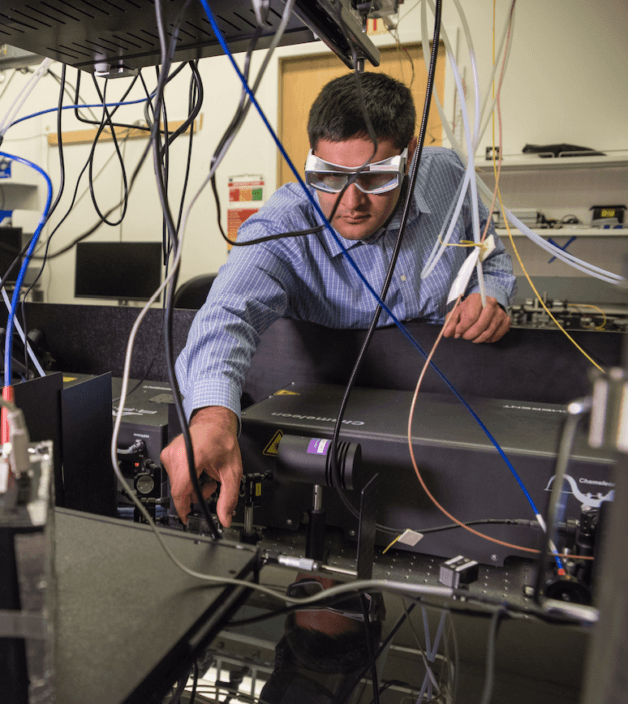Nov 16 2016
 The Molecular Foundry’s Edward Barnard is part of a team of scientists that developed a new way to see inside solar cells. (Credit: Marilyn Chung)
The Molecular Foundry’s Edward Barnard is part of a team of scientists that developed a new way to see inside solar cells. (Credit: Marilyn Chung)
Next-generation solar cells made of super-thin films of semiconducting material have a lot of potential as they are relatively economical and flexible enough to be used almost anywhere.
Scientists are working to significantly increase the efficiency at which thin-film solar cells change sunlight to electricity. However it is a difficult task, partly due to the subsurface realm of a solar cell (where most of the energy-conversion action occurs), which is inaccessible to real-time, nondestructive imaging. It is tough to enhance processes one can not see.
Recently, a team of researchers from the Department of Energy’s Lawrence Berkeley National Laboratory (Berkeley Lab) have developed a method to map thin-film solar cells in 3D as they absorb photons using optical microscopy.
The technique was developed at the Molecular Foundry, a DOE Office of Science user facility located at Berkeley Lab. The details can be found in the November 15 issue of the journal Advanced Materials.
Optoelectronic dynamics in materials can be imaged at the micron scale, or much thinner than the diameter of a human hair using this technique. This is small enough to observe substrate interfaces, separate grain boundaries, and other internal obstacles that can capture excited electrons and prevent them from getting to an electrode, which drains the efficiency of a solar cell.
So far, researchers have used the method to better understand the reason why adding a definite chemical to solar cells composed of cadmium telluride (CdTe) - the most common thin-film material - enhances the performance of the solar cells.
To make big gains in photovoltaic efficiency, we need to see what’s happening throughout a working photovoltaic material at the micron scale, both on the surface and below, and our new approach allows us to do that.
Edward Barnard, Principal Scientific Engineering Associate, Molecular Foundry
He led the study with James Schuck, the director of the Imaging and Manipulation of Nanostructures facility at the Molecular Foundry.
The imaging technique became a reality due to a partnership between Molecular Foundry scientists and Foundry users from PLANT PV Inc., an Alameda, California-based company. The team discovered that standard optical methods could not image the inner-workings of the materials while fabricating new solar cell materials at the Molecular Foundry, so they developed the new method to achieve this view.
Scientists from the National Renewable Energy Laboratory went to the Molecular Foundry and used the new technique to analyze CdTe solar cells.
To develop the process, the researchers modified a method known as two-photon microscopy (which is used by biologists to observe the inner-workings of thick samples such as living tissue) so that it can be applied to mass semiconductor materials.
The technique uses a highly focused laser beam of infrared photons that enter inside the photovoltaic material. When two low-energy photons meet at the same pinpoint, there is enough energy to stimulate electrons. These electrons can be observed to see how long they endure in their excited state, with extended-lifetime electrons becoming visible as bright spots in microscopy images. In a solar cell, extended-lifetime electrons have the potential to reach an electrode.
The laser beam can be methodically repositioned across a test-sized solar cell, developing a 3D map of a solar cell’s whole optoelectronic dynamics. The technique has already provided information regarding the advantages of treating CdTe solar cells with cadmium chloride, which is frequently incorporated during the fabrication process.
Scientists are aware that cadmium chloride enhances the efficiency of CdTe solar cells, however its effect on excited electrons at the micron scale is yet to be fully understood. Studies have revealed that the chlorine ions mostly pile up at grain boundaries, but how this alters the life span of excited electrons is vague.
With the latest imaging method, the team were able to discover that the cadmium chloride treatment boosts the lifetime of excited electrons not only at the grain boundaries but also within the grains themselves. This can be easily observed in 3D images of CdTe solar cells with and without the treatment.
The treated solar cell “glows” much more evenly across the whole material, both in the grains and the spaces in between the grains.
“Scientists have known that cadmium chloride passivation improves the lifetime of electrons in CdTe cells, but now we’ve mapped at the micron scale where this improvement occurs,” says Barnard.
The new imaging method could assist scientists in making better decisions about enhancing a number of thin-film solar cell materials, besides CdTe, such as organic compounds and perovskite.
Researchers trying to push photovoltaic efficiency could use our technique to see if their strategies are working at the microscale, which will help them design better test-scale solar cells—and eventually full-sized solar cells for rooftops and other real-world applications.
Edward Barnard, Principal Scientific Engineering Associate, Molecular Foundry
The research was supported from the Department of Energy’s Office of Science and by a SunShot Initiative award from the Office of Energy Efficiency and Renewable Energy.
Imaging Solar Cells in 3-D
Berkeley Lab scientists have developed a way to use optical microscopy to map thin-film solar cells in 3-D as they absorb photons. (CREDIT - Berkeley Lab)